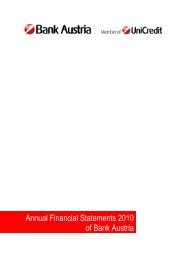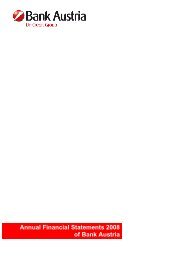Annual Financial Statements 2011 of Bank Austria
Annual Financial Statements 2011 of Bank Austria
Annual Financial Statements 2011 of Bank Austria
You also want an ePaper? Increase the reach of your titles
YUMPU automatically turns print PDFs into web optimized ePapers that Google loves.
Notes to the <strong>Financial</strong> <strong>Statements</strong> <strong>of</strong> UniCredit <strong>Bank</strong> <strong>Austria</strong> AG<br />
2.2.2. Loans and advances<br />
Provisions were made for identifiable lending risks. To<br />
the extent that it was possible to combine individual<br />
risk assets into groups, provisions were made on a<br />
portfolio basis.<br />
2.2.3. Securities<br />
Securities intended to be held as long-term<br />
investments were valued at cost. Use was made <strong>of</strong> the<br />
optional rule contained in Section 56 (2) and (3) <strong>of</strong> the<br />
<strong>Austria</strong>n <strong>Bank</strong>ing Act (spreading premiums/discounts<br />
in the pr<strong>of</strong>it and loss account over the period to<br />
maturity). The relevant amounts <strong>of</strong> premiums and<br />
discounts are indicated in item 4 <strong>of</strong> the notes to the<br />
balance sheet (4.7. Differences between cost and<br />
repayable amount <strong>of</strong> bonds and other fixed-income<br />
securities).<br />
Securities held in the trading book were marked to<br />
market. Other securities held as current assets were<br />
valued at cost or market, whichever was lower. Own<br />
issues that were repurchased were stated in the<br />
balance sheet at average cost. Details are given in<br />
item 4 <strong>of</strong> the notes to the balance sheet<br />
(4.8. Differences between cost and market value <strong>of</strong><br />
securities admitted to trading on an exchange which<br />
are not held as financial fixed assets).<br />
2.2.4. Equity interests and shares in group<br />
companies<br />
Equity interests and shares in group companies were<br />
stated at cost. In the case <strong>of</strong> a permanent decline in<br />
value, write-downs were made in respect <strong>of</strong> listed and<br />
unlisted companies.<br />
Impairment test<br />
For the impairment test the Standard UniCredit Group<br />
Discounted Cash Flow Valuation Model (3-phase<br />
model) was employed throughout the Group using the<br />
following assumptions:<br />
� Phase 1 (<strong>2011</strong>): the figures are based on year-end<br />
projections for net pr<strong>of</strong>it and risk-weighted assets<br />
<strong>of</strong> the respective cash-generating units.<br />
� Phase 2 (2012–2021):<br />
Phase 2a – planning period (2012–2015): the<br />
2012 budget figures for net pr<strong>of</strong>it and riskweighted<br />
assets were used for 2012, and multiyear<br />
planning figures were used for subsequent<br />
years.<br />
Phase 2b (2016–2021): in this phase the growth<br />
rates <strong>of</strong> net income and risk-weighted assets<br />
converge towards 2%. The discount rate in the<br />
form <strong>of</strong> cost <strong>of</strong> equity (Ke) declines to the<br />
corresponding terminal value level.<br />
� Phase 3 – perpetual annuity: calculation <strong>of</strong> the<br />
present value <strong>of</strong> a perpetual annuity on the<br />
assumption <strong>of</strong> a long-term growth rate which takes<br />
the sustained long-term economic growth<br />
expected by <strong>Bank</strong> <strong>Austria</strong> for the euro area into<br />
account (2%).<br />
Phase 2a is the result <strong>of</strong> a detailed planning process<br />
which does not exceed the 5-year horizon in<br />
accordance with IAS 36. The purpose <strong>of</strong> Phase 2b is<br />
to illustrate the expected long-term convergence <strong>of</strong><br />
growth rates in these markets to those in Europe.<br />
Calculation <strong>of</strong> cost <strong>of</strong> equity<br />
The expected cash flows are discounted at the<br />
country-specific rate <strong>of</strong> cost <strong>of</strong> capital, which is<br />
determined on the basis <strong>of</strong> the long-term risk-free<br />
interest rate <strong>of</strong> the local currency, the debt risk<br />
premium and the UniCredit equity risk premium.<br />
� Risk-free rate: Calculation is based on the<br />
historical average (6 years) <strong>of</strong> the 5-year swap rate<br />
in local currency. If no swap rate was available, the<br />
most liquid and comparable interbank rate (with a<br />
3-month tenor) was used.<br />
<strong>Bank</strong> <strong>Austria</strong> – <strong>Annual</strong> <strong>Financial</strong> <strong>Statements</strong> <strong>2011</strong> 216
















